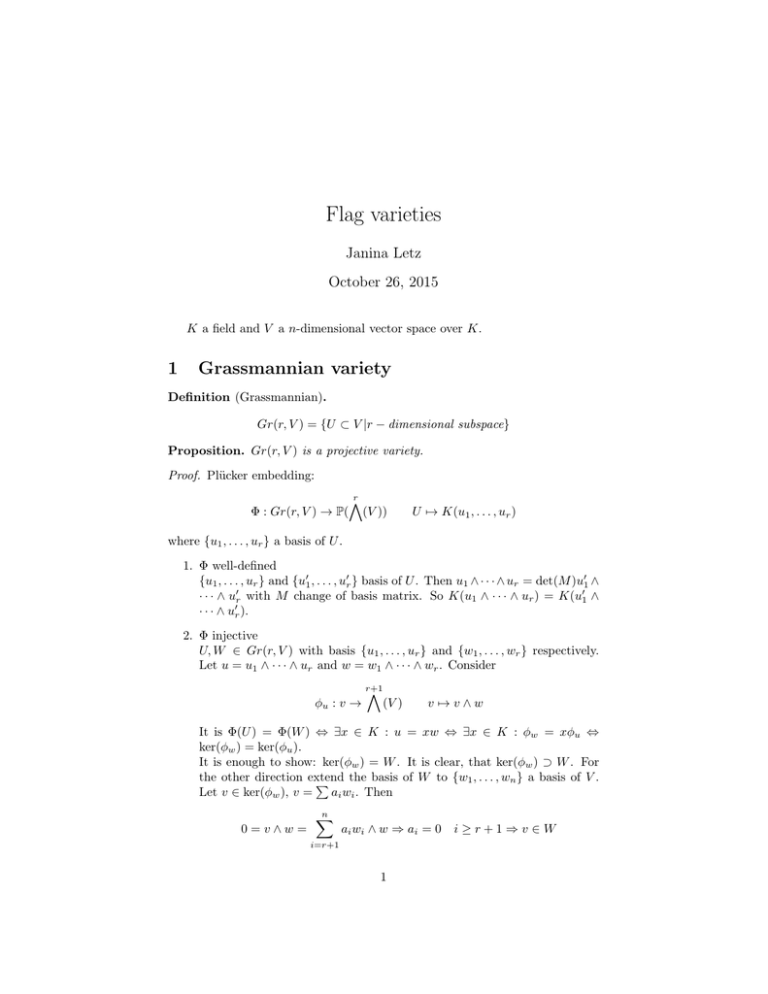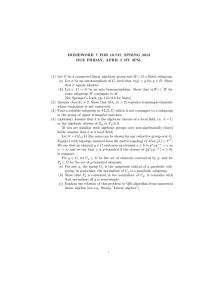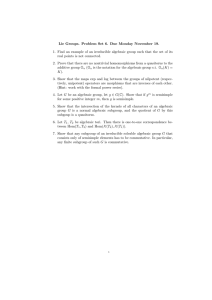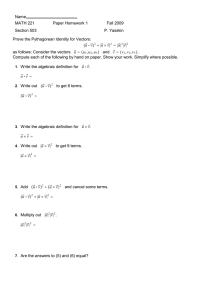Flag varieties 1 Grassmannian variety Janina Letz
advertisement

Flag varieties
Janina Letz
October 26, 2015
K a field and V a n-dimensional vector space over K.
1
Grassmannian variety
Definition (Grassmannian).
Gr(r, V ) = {U ⊂ V |r − dimensional subspace}
Proposition. Gr(r, V ) is a projective variety.
Proof. Plücker embedding:
Φ : Gr(r, V ) → P(
r
^
(V ))
U 7→ K(u1 , . . . , ur )
where {u1 , . . . , ur } a basis of U .
1. Φ well-defined
{u1 , . . . , ur } and {u01 , . . . , u0r } basis of U . Then u1 ∧ · · · ∧ ur = det(M )u01 ∧
· · · ∧ u0r with M change of basis matrix. So K(u1 ∧ · · · ∧ ur ) = K(u01 ∧
· · · ∧ u0r ).
2. Φ injective
U, W ∈ Gr(r, V ) with basis {u1 , . . . , ur } and {w1 , . . . , wr } respectively.
Let u = u1 ∧ · · · ∧ ur and w = w1 ∧ · · · ∧ wr . Consider
φu : v →
r+1
^
(V )
v 7→ v ∧ w
It is Φ(U ) = Φ(W ) ⇔ ∃x ∈ K : u = xw ⇔ ∃x ∈ K : φw = xφu ⇔
ker(φw ) = ker(φu ).
It is enough to show: ker(φw ) = W . It is clear, that ker(φw ) ⊃ W . For
the other direction extend
the basis of W to {w1 , . . . , wn } a basis of V .
P
Let v ∈ ker(φw ), v =
ai wi . Then
0=v∧w =
n
X
ai wi ∧ w ⇒ ai = 0 i ≥ r + 1 ⇒ v ∈ W
i=r+1
1
Vr
3. Φ is closed in P( (V ))
Vr
Vr+1
(a) v ∈ V, w ∈
(V ). Then v divides w ⇔ v ∧ w = 0 in
(V )
One direction is clear. For
the
other
choose
a
basis
{v
,
.
.
.
,
vn } of V
1
P
with v = v1 . Then w = 1≤i1 <···<ir ≤n ai1 ...ir vi1 ∧ · · · ∧ vir . Then for
0 = v ∧ w it is ai1 ...ir = 0 if i1 6= 1. So v divides w.
Vr
(b) w ∈
(V ). Let
w1 , . . . , wt be a basis of ker(φw ). So w = w1 ∧ · · · ∧
Vr−t
wt ∧ u for u ∈
. So dim(ker(φw )) ≤ r ⇒ rank(φw ) ≥ n − r. On
the other hand it is w = w1 ∧ · · · ∧ wr ⇒ rank(φw ) = n − r.
So: w decomposable ⇔ rank(φw ) = n − r ⇔ rank(φw ) ≤ n − r.
Vr
P
(c) Let w ∈
(V ) with w =
ai1 ...ir vi1 ∧ · · ·V∧ vir . ai1 ...ir are Vcalled
r
r
Plücker coordinates of W . They associate P( (V )) with Pdim( (V ))−1 .
Then
Kw ∈ im(Φ) ⇔ rank(φw ) ≤ n − r ⇔ rank(M (φw )) ≤ n − r
for
M (φw ) = (bjf (k) )j=1...n,k=1...( n )
r+1
(
0
j ≤ ik ∀k
bji1 ...ir+1 =
k
(−1) ai1 ...îk ...ir+1 ik = j
n
for f : {1 . . . r+1
→ {(i1 , . . . , ir+1 )|1 ≤ i1 < · · · < ir+1 } a bijection
of sets. So Gr(r, V ) ∼
= V ({(n + r − 1)-minor of B = 0}).
It is: Gr(n − r, V ) ∼
= Gr(r, V ) and Gr(1, V ) ∼
= P(V ) ∼
= Pdim(V )−1 .
Example. Let V a 4-dimensional vector space with basis {v1 , . . . , v4 }.
• Let W ∈ Gr(1, V ) with basis {w}.
w=
Matrix representation of φw :
a2 −a1
a3
0
a4
0
0
a
3
0
a4
0
0
X
ai vi
0
−a1
0
−a2
0
a4
0
0
−a1
0
−a2
−a3
Gr(1, V ) ∼
= V ({0}) ∼
= P3
2
• Let W ∈ Gr(2, V ) with basis {w1 , w2 }.
X
X
X
w1 =
a i vi
w2 =
bi v i
w1 ∧ w2 =
(ai bj − aj bi ) vi ∧ vj
|
{z
}
i<j
aij
Matrix representation of φw1 ∧w2 :
a23 −a13
a24 −a14
a34
0
0
a34
a12
0
−a14
−a24
0
a12
a13
a23
So there are 16 equations.
V2
Another way: Use, that for u ∈
(V ) it is ∃ui ∈ V for u = u1 ∧ u2 ⇔
u ∧ u = 0. So
Gr(2, V ) ∼
= V (X12 X34 − X13 X24 + X14 X23 )
• Let W ∈ Gr(3, V ) with basis {w1 , w2 , w3 }.
X
X
w1 =
ai vi
w2 =
bi v i
w1 ∧w2 ∧w3 =
X
i<j<k
w3 =
X
ci vi
(ai bj ck + aj bk ci + ak bi cj − ak bj ci − aj bi ck − ai bk cj ) vi ∧vj ∧vk
|
{z
}
aijk
Matrix representation of φw1 ∧w2 ∧w3 :
a234
−a134
a124
−a123
Gr(3, V ) ∼
= V ({}) ∼
= P3
2
Flag variety
Definition (Flag variety).
F (V ; n1 , . . . , nr ) = {0 ⊂ V1 ⊂ · · · ⊂ Vr ⊂ V | dim(Vi ) = ni }
for 1 ≤ n1 < · · · < nr ≤ n a sequence of integers.
Proposition. F (V ; n1 , . . . , nr ) is a projective variety.
Proof.
Ψ : F (V ; n1 , . . . , nr ) → Gr(n1 , V ) × · · · × Gr(nr , V )
is an embedding. Show the image is closed.
3
{Vi } 7→ (V1 , . . . , Vr )
1. Consider the projection πij : Gr(n1 , V ) × · · · × Gr(nr , V ) → Gr(ni , V ) ×
Gr(nj , V ) for i < j. Then
\
−1
Ψ(F (V ; n1 , . . . , nr )) =
πij
(πij (Ψ(F (V ; n1 , . . . , nr ))))
i<j
So it is enough to prove Ψ(F (V ; r, s)) is closed in Gr(r, V ) × Gr(s, V ) for
r < s.
2. (U, W ) ∈ Gr(r, V ) × Gr(s, V ) and {u1 , . . . , ur ) and {w1 , . . . , ws } basis of
U and W and u = u1 ∧ · · · ∧ ur and w = w1 ∧ · · · ∧ ws . Then
φu ⊕ φw : V →
r+1
^
(V ) ⊕
s+1
^
(V )
ker(φu ⊕ φw ) = U ∩ W
So rank(φu ⊕ φw ) = n − dim(U ∩ W ) ≥ n − r. This means
U ⊂ W ⇔ rank(φu ⊕ φw ) = n − r ⇔ rank(φu ⊕ φw ) ≤ n − r
This gives polynomial equations in the elements of the matrices of φu and
φw . So F (v; r, s) is a projective variety.
Example. Let V be a 4-dimensionalPvector space. (U, W )P∈ F (V ; 1, 2), {u}
and {w1 , w2 } basis of U and W . u = ai vi and w1 ∧ w2 = i<j aij vi ∧ vj . So
u ∧ w1 ∧ w2 =
X
(ai ajk − aj aik + ak aij )vi ∧ vj ∧ vk
i<j<k
Then U ⊂ W ⇔ u ∧ w1 ∧ w2 = 0. So F (V ; 1, 2) ∼
= V ({X1 X23 − X2 X13 +
X3 X12 , . . . }) ⊂ P9 .
Definition (Complete). A flag variety of the form F (V ; 1, . . . , n) is called complete.
3
Algebraic groups
Definition (Algebraic group). let G be an algebraic variety with two morphism
of algebraic varieties m : G × G → G and i : G → G, such that G is a group
with multiplication m and i as inverse map. Then G is an algebraic group.
2
2
Example. Gl(n, k) = An \V (det) ∼
= V (Xn2 −1 det −1) ⊂ An +1 via (a1 , . . . , an2 ) 7→
1
(a1 , . . . , an2 , det((a
). Then the multiplication is matrix multiplication in the
i ))
2
first n coordinates and multiplication of the last coordinate in the last coordinate. The inverse map is the last component times the adjugate of the first
n2 components and the determinant of the first n2 coordiantes in the last one.
Since these maps are polynomials, they are morphisms of algebraic varieties.
4
Definition (Linear). An algebraic group G is linear, if G ≤ Gl(n, k).
Lemma. Let G be an algebraic group. Then G is linear ⇔ G is affine.
Example. The upper triangle matrices: T (n, k) = V ({Xij |i < j}) ∩ Gl(n, k) ⊂
Gl(n, k).
From now G is a linear algebraic group.
Definition. G an algebraic group and X an algebraic variety. Then G acts on
X, if there is a map G × X → X, that is a group action and a morphism of
algebraic varieties.
Example.
• Gl(V ) acts on Gr(r, V ): (A, W ) 7→ A(W )
• Gl(V ) acts on Gr(n1 , V ) × · · · × Gr(nr , V )
• Gl(V ) acts on F (V ; n1 , . . . , nr )
Proposition. Gl(V ) acts transitively on flag varieties.
Proof. Let {Uni }, {Wni } ∈ F (V ; n1 , . . . , nr ). Then choose basis {u1 , . . . , un }
and {w1 , . . . , wn } of V , such that {u1 , . . . , uni } a basis of Uni and {w1 , . . . , wni }
basis of Wni . Then define A ∈ Gl(V ) as A(ui ) = wi .
Let {Vi } ∈ F (V ; 1, . . . , n) and {v1 , . . . , vn } a basis corresponding to {Vi }.
Then Gl(V ) ∼
= Gl(n, K) by the basis and the stabilizer of {Vi } is isomorphic to
T (n, K).
If H is a closed subgroup of G, then G/H is an algebraic variety with a
canonical projection π : G → G/H, st for a morphism of algebraic varieties
φ : G → V , where each nonempty φ−1 (v) is a union of cosets ofH, there exists
a unique morphsm σ : G/H → V of algebraic varieties with σ ◦ π = φ.
Definition (Homogeneous). An algebraic variety X is called homogeneous, if
there exists an algebraic group G, a group action G × V → V and a closed
subgroup H ≤ G with X ∼
= G/H.
Then X homogeneous ⇔ G acts transitively on X.
Example.
• Let V be a 4-dimensional vector space. Fix (U, W ) ∈ F (V ; 1, 2)
with basis {v1 } ⊂ {v1 , v2 } ⊂ {v1 , . . . , v4 }. Then the stabilizer is
∗ ∗ ∗ ∗
0 ∗ ∗ ∗
H∼
F (V ; 1, 2) ∼
=
= Gl(4, K)/H
0 0 ∗ ∗
0 0 ∗ ∗
• F (V ; 1, . . . , n) ∼
= Gl(n, K)/T (n, K),
Definition (Borel subgroup). Let G be an algebraic group. Then a Borel subgroup of G is a maximal connected solvable subgroup of G.
5
• all Borel subgroups are conjuagte
• all conjugates of a Borel subgroup are Borel subgroups
• G/B is a complete variety
• H a closed connected subgroup of G. Then H is a Borel subgroup of G
if and only if H contains no proper subgroups H 0 with G/H 0 a projective
variety.
Example. T (n, K) is a Borel subgroup of Gl(n, K), because T (n, K) is closed,
solvable and connected. With the Lie-Kolchin theorem (if H is a connected
solvable subroup of Gl(n, K), then H is conjugate to a subgroup of T (n, K)) it
is maximal.
So complete flags are complete varieties and the Borel subgroups of Gl(V ) are
the stabilizers of complete flags.
For a closed subgroup P it is: G/P projective variety ⇔ P contains a Borel
subgroup.
Definition (Parabolic). A closed subgroup P of an algebraic group G is parabolic,
if G/P is a projective variety.
Every stabilizer of a flag is a parabolic subgroup.
Proposition. Every parabolic subgroup of Gl(n, K) is the stabilizer of some
flag.
Proof. Let P be a parabolic subgroup. Then P contains a Borel subgroup. Wlog
P ⊂ T (n, K). Then the elements of P have block matrix form with blocks of
Pi
size mi , i = 1..r. Consider the sequence ni =
j=1 mi . Since Gl(V ) acts
transitively on F (V ; n1 , . . . , nr ), there exists a basis and an element {Vni }, such
that P is the stabilizer of {Vni }.
So the parabolic subroups of Gl(V ) are the subgroups, that stabilizes some
flag.
6



